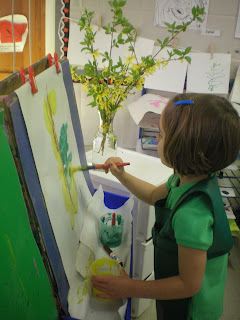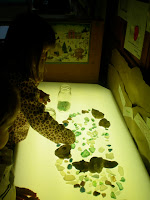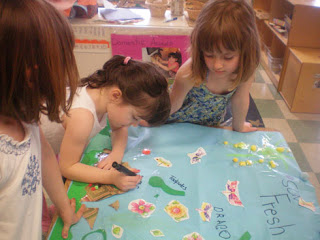“Knowledge without love will not stick. But if love comes first, knowledge is sure to follow.”
— John Burroughs (American naturalist, 1837 – 1921)
Curriculum refers to all the experiences that are organized and provided for by an educational program. The classroom environment, materials and management of time and space all contribute to support the curriculum. Programs that have established themes are teacher-directed and children are presented with activities and experiences accordingly.
In contrast, educational programs that support an emergent curriculum such as the Reggio Approach, and Bank Street philosophy are based on a child's interest, developmental stage, and individual cultural and social background. The teachers listen and record the interest and ideas of the children. They ask open-ended questions and provide materials and opportunities to provoke further exploration. The teacher is a co-learner and collaborator with the child in keeping with the educational theories of Lev Vygotsky, Jerome Bruner and John Dewey who value social and active learning within the environment. Vygotsky calls this social constructivism. This curriculum is not static but negotiated as teachers, children and the environment enjoy active and interactive roles in learning.
Time and space for small group interactions and project-type studies support sharing, caring and relationship for endless expressions of learning and growth.

 Curriculum that takes advantages of the many languages of communication a child's uses to express their knowledge and view of the world include opportunities to develop confidence in areas such as speaking, writing, reading, mathematics, science, construction, movement, drawing, painting, sculpting, collage, construction, dramatic play, shadow, wind & nature play and music.
Curriculum that takes advantages of the many languages of communication a child's uses to express their knowledge and view of the world include opportunities to develop confidence in areas such as speaking, writing, reading, mathematics, science, construction, movement, drawing, painting, sculpting, collage, construction, dramatic play, shadow, wind & nature play and music.
Learning Environment
"... education is a natural process carried out by the human individual, and is acquired not by listening to words, but by experiences in the environment.”
 (Montessori, 1946, Education in a New World)
(Montessori, 1946, Education in a New World)
 Learning environments that reflect and support a responsive curriculum will be designed for active learning, observation, and social relationships. The environment is cognitively stimulating and aesthetically appointed. Reggio inspired classrooms offer spaces for working in small groups and large groups, and documentation of the life within cover walls and halls.
Learning environments that reflect and support a responsive curriculum will be designed for active learning, observation, and social relationships. The environment is cognitively stimulating and aesthetically appointed. Reggio inspired classrooms offer spaces for working in small groups and large groups, and documentation of the life within cover walls and halls.
Atelier and mini-atelier (art studios) provide a special space for creative thinking and expression. Materials include clay, wire, paint, papers, brushes, fabric, yarns and the like. An alterista (studio teacher) works with the children.
Reggio inspired environments are beautiful and unique to each school and classroom. Light is everywhere as a metaphor for the transparency of being open to new ideas, families and the community.
Nature and natural materials, and recycled materials show respect for our earth's resources. Equipment and materials are accessible and organized for easy care and use by the children.
Routines are minimal not to rush or interrupt learning. Sharing a meal is part of the children's day encouraging social and health etiquette.
Documentation of the process of learning and making learning visible for the children, families and wider community is paramount. It is a vital element in Reggio inspired practices, and I believe any "best practice" in early childhood education should have a strong base in documentation.
Technology today makes this an exciting and infinitely creative process for teachers and incredible catalyst for parent involvement as it provides insight into the who, what, where and how their child is being educated and nurtured. Still images with a few descriptive words of the process, the children's dialogue and queries bring you into the child's world. Sound videos with narratives such as videatives are also very powerful offering the added dimension of physical movement to convey a host of interpretations and perceptions.
Documentation is a vital tool for assessment of both child and teacher. Images with text give a more holistic understanding ~ a broader and deeper opportunity for reflection, and serves to preserve history. As they say," A picture is worth a thousand words."
Documentation can take the form of panels, a book, a portfolio, or journal. It can be paper or digital. Documentation enhances a fine art, literacy, science or construction project display. There are limitless possibilities!
Click here to read an informative article about documentation. Reggio Emilia: Part of the brilliance is the documentation By Kathleen Tehrani. original source: examiner.com/education
— John Burroughs (American naturalist, 1837 – 1921)
Curriculum refers to all the experiences that are organized and provided for by an educational program. The classroom environment, materials and management of time and space all contribute to support the curriculum. Programs that have established themes are teacher-directed and children are presented with activities and experiences accordingly.
In contrast, educational programs that support an emergent curriculum such as the Reggio Approach, and Bank Street philosophy are based on a child's interest, developmental stage, and individual cultural and social background. The teachers listen and record the interest and ideas of the children. They ask open-ended questions and provide materials and opportunities to provoke further exploration. The teacher is a co-learner and collaborator with the child in keeping with the educational theories of Lev Vygotsky, Jerome Bruner and John Dewey who value social and active learning within the environment. Vygotsky calls this social constructivism. This curriculum is not static but negotiated as teachers, children and the environment enjoy active and interactive roles in learning.
Time and space for small group interactions and project-type studies support sharing, caring and relationship for endless expressions of learning and growth.

 Curriculum that takes advantages of the many languages of communication a child's uses to express their knowledge and view of the world include opportunities to develop confidence in areas such as speaking, writing, reading, mathematics, science, construction, movement, drawing, painting, sculpting, collage, construction, dramatic play, shadow, wind & nature play and music.
Curriculum that takes advantages of the many languages of communication a child's uses to express their knowledge and view of the world include opportunities to develop confidence in areas such as speaking, writing, reading, mathematics, science, construction, movement, drawing, painting, sculpting, collage, construction, dramatic play, shadow, wind & nature play and music. Learning Environment
"... education is a natural process carried out by the human individual, and is acquired not by listening to words, but by experiences in the environment.”
 (Montessori, 1946, Education in a New World)
(Montessori, 1946, Education in a New World) Learning environments that reflect and support a responsive curriculum will be designed for active learning, observation, and social relationships. The environment is cognitively stimulating and aesthetically appointed. Reggio inspired classrooms offer spaces for working in small groups and large groups, and documentation of the life within cover walls and halls.
Learning environments that reflect and support a responsive curriculum will be designed for active learning, observation, and social relationships. The environment is cognitively stimulating and aesthetically appointed. Reggio inspired classrooms offer spaces for working in small groups and large groups, and documentation of the life within cover walls and halls. Atelier and mini-atelier (art studios) provide a special space for creative thinking and expression. Materials include clay, wire, paint, papers, brushes, fabric, yarns and the like. An alterista (studio teacher) works with the children.
Reggio inspired environments are beautiful and unique to each school and classroom. Light is everywhere as a metaphor for the transparency of being open to new ideas, families and the community.
Nature and natural materials, and recycled materials show respect for our earth's resources. Equipment and materials are accessible and organized for easy care and use by the children.
Routines are minimal not to rush or interrupt learning. Sharing a meal is part of the children's day encouraging social and health etiquette.
Documentation of the process of learning and making learning visible for the children, families and wider community is paramount. It is a vital element in Reggio inspired practices, and I believe any "best practice" in early childhood education should have a strong base in documentation.
Documentation is a vital tool for assessment of both child and teacher. Images with text give a more holistic understanding ~ a broader and deeper opportunity for reflection, and serves to preserve history. As they say," A picture is worth a thousand words."
Documentation can take the form of panels, a book, a portfolio, or journal. It can be paper or digital. Documentation enhances a fine art, literacy, science or construction project display. There are limitless possibilities!
Click here to read an informative article about documentation. Reggio Emilia: Part of the brilliance is the documentation By Kathleen Tehrani. original source: examiner.com/education














